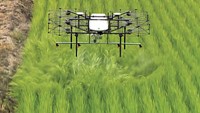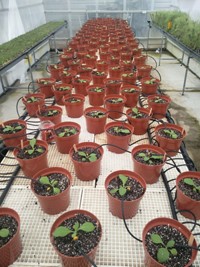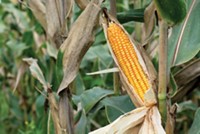Advertisement
Grab your lab coat. Let's get started
Welcome!
Welcome!
Create an account below to get 6 C&EN articles per month, receive newsletters and more - all free.
It seems this is your first time logging in online. Please enter the following information to continue.
As an ACS member you automatically get access to this site. All we need is few more details to create your reading experience.
Not you? Sign in with a different account.
Not you? Sign in with a different account.
ERROR 1
ERROR 1
ERROR 2
ERROR 2
ERROR 2
ERROR 2
ERROR 2
Password and Confirm password must match.
If you have an ACS member number, please enter it here so we can link this account to your membership. (optional)
ERROR 2
ACS values your privacy. By submitting your information, you are gaining access to C&EN and subscribing to our weekly newsletter. We use the information you provide to make your reading experience better, and we will never sell your data to third party members.
Environment
Farm In A Lab
In the heart of Europe, BASF turns to genetic engineering to increase crop yields
by Melody Voith
October 20, 2008
| A version of this story appeared in
Volume 86, Issue 42

IN AN IMMACULATE greenhouse in the painterly countryside near Ghent, Belgium, thousands of rice plants spend their lives under a strictly controlled but seemingly benign regimen of light, water, and soil nutrients.
So visitors are surprised to learn that any effluent from the facility must be treated as hazardous industrial waste. The plants at this CropDesign research site are the products of genetic engineering and are not allowed outside its walls. And although genetically modified (GM) seeds may help meet the world's growing demand for food, they face poor odds of ever being sown in the fields of Europe.
CropDesign is a subsidiary of BASF. It is also part of a collaboration between BASF and Monsanto, the world leader in GM crops that are resistant to herbicides and insects. Formed in 2007, the collaboration seeks to develop a new generation of corn, soybean, cotton, and canola crops with improved yield and the ability to resist environmental stressors such as drought and low-nitrogen soil.
Monsanto and BASF are moving ahead despite the fact that European regulatory approval of genetically modified organisms (GMOs) is uncertain. The European Union has not given the green light to any GM seeds since its 1998 approval of Monsanto's insect-resistant corn. But agriculture is a global business. Hans Kast, head of BASF Plant Science, points out that in 2007 GM crops were planted in 23 countries across 281 million acres, a larger area than all the farmland in Europe.
The world's need for new GM crops is clear, Kast says. "We believe that the only technology to meet future demand is plant biotechnology," he declares.
Although BASF is a late entrant into biotechnology, its research portfolio makes it an attractive partner for Monsanto, says Steve Padgette, vice president of Monsanto Biotechnology. Each firm has its own discovery program, but they come together to develop the promising genetic leads they find. The effort has a budget of up to $1.5 billion. Development costs are split evenly, and Monsanto takes over at the commercial stage, keeping 60% of the revenue.
On average it will take eight to 10 years and between $80 million and $100 million to develop seeds with yield-improving and stress-resistant traits, according to Padgette. The partnership plans to have its first commercial product, a drought-tolerant strain of corn, available after 2012. Padgette says that the corn seed was field-tested in dry agricultural zones from South Dakota to Texas where it increased yields by 13 to 15%, outperforming three traditional seeds. Traditional breeding usually brings yield increases of 1% per generation, he adds.
Corn, soybean, and canola seeds that are engineered to produce higher yields are farther behind in the pipeline and have just entered field trials. Back in the lab, researchers are working to develop drought-tolerant cotton and corn that use nitrogen more efficiently. The two companies estimate that the new generation of traits for commodity crops will have an overall market value of $50 billion by 2025.
Gautam Sirur of the agricultural consultancy Cropnosis forecasts that drought-tolerant traits alone will bring in $12 billion per year by then. However, he cautions that the partners' main competitors—Syngenta, DuPont's Pioneer Hi-Bred, and Bayer CropScience—all have yield and stress research programs of their own.
Padgette says farmers are now willing to spend more on seeds because they can get more money for their crops. He attributes the rise in commodity prices to increases in population, more meat consumption by a growing Asian middle class, and the use of grain for fuel.

ACCORDING TO the U.S. Department of Agriculture, farmers will be hard-pressed to meet increasing demand with current agricultural practices. Globally, growth in average yield per acre is slowing. Yields increased 2.0% per year from 1970 to 1990 but then dropped to 1.1% from 1990 to 2007.
As productivity gains from traditional inputs—plant breeding, irrigation, and chemicals—slowed, chemical firms turned to biotechnology to increase yield. Monsanto has recast itself as a life sciences company, whereas BASF, Bayer, and Dow are adding products based on plant genetics to their crop protection businesses.
Increasing yield per acre has long been a promised benefit of GMO technologies. But given the seed industry's reliance on herbicide tolerance and insect-resistance traits, some critics are skeptical about the motivation of seed makers. "We've been hearing about these traits for 10 years or longer; they've never made it on to the market," says Helen Holder, GMO coordinator for Friends of the Earth Europe.
Plant researchers acknowledge that the world has waited a long time for the new traits, but they note that increased yield or stress tolerance is much more difficult to impart than herbicide and insect resistance. "It's like night and day," says Roger Kemble, head of crop genetics research at Syngenta. The earlier advances came from changing a single gene, Kemble says, but newer traits "are much more complex, and a single gene is not going to solve the problem."
"What's clear is that farmers in parts of the world where they can grow genetically modified crops will do so."
BASF's Kast says the partnership with Monsanto is all about speeding up the time to develop traits. But even though the two firms look for the same outcomes, "what was surprising was that when we combined the list of leads from our separate discovery processes, the overlap was only about 10%, because we take different approaches to finding gene targets," he says.
At BASF's research centers, scientists strive to understand the gene functions of plants. They zero in on desired traits from two perspectives: by looking at the plant's appearance—its phenotype—and by understanding the metabolic profile of the plant genotype.
The researchers at CropDesign grow rice as a model plant. Rice and corn share a similar genome, and rice plants are better suited to CropDesign's high-throughput methods, according to Johan Cardoen, the company's chief executive director. Finding the plants with winning traits requires "scale, speed, and comprehensiveness," he says.
Inside the CropDesign greenhouse in Ghent, thousands of rice plants in clear plastic pots traverse sections of the facility on conveyer belts to even out any variation in the controlled indoor environment. Within these neighborhoods, the plants grow under different conditions indicated by signs labeled "optimal," "drought," or "low nitrogen."
The route around the greenhouse includes a stop inside an imaging unit. At critical points during a plant's growth cycle, cameras capture the status of every aspect of the plant, from roots to seeds to leaf color. Specialized algorithms translate the images into data describing 20 parameters of agricultural performance. A bar code and radio-frequency identification chip track each plant and store information about its characteristics and history.
Under these controlled conditions, it's a good bet that trait differences in the plants are due to genetic, not environmental, variations, Cardoen says. If a particular plant produces large seeds or other desirable traits, researchers use in-house bioinformatics tools to select the genes that may be responsible. They use a common soil bacterium to insert the genes into a rice plant cell in a process called "transformation." Then researchers grow new seeds from the cell. The next generation of plants is imaged to see whether they display the desired characteristic.
AUTOMATED TOOLS and robots mean the facility can screen more than 140,000 plants per year and run 24 hours a day, seven days a week. Every day the imaging system processes 50,000 snapshots, producing many terabytes of plant data.
BASF also absorbs great quantities of plant data from CropDesign's sister company, Metanomics, located in Berlin. But the data come from inside the plant???from the analysis of compounds extracted from flash-frozen leaves. Metanomics' managing director, Arno Krotzky, likens his company's approach to looking at a car's engine—rather than examining external features—to learn what makes it fast.
"We are trying to understand how plants function and the actual genetic drivers that are behind a trait," Krotzky says. To do this, his team examines the metabolites in the Arabidopsis thaliana plant. The chemical extracts serve as a "rapid and sensitive diagnostic sensor of a gene's function." Metanomics can measure tiny amounts of metabolites, including fats, amino acids, and sugars.
Metanomics operates 70 mass spectrometers and gas chromatographs that analyze metabolites in 110,000 samples per year. The data show the effect of adding a new gene or switching off an existing gene.
To examine the mechanisms that determine plant health, a researcher might investigate a moss gene to see whether it confers drought resistance, Krotzky says. "We have the largest gene function database in the world, with 35,000 genes. This 'plant Google' helps us select the best gene mechanism for a desired trait."
Researchers at CropDesign and Metanomics work together, as well as separately, to identify lead genes. Any lead covered by the BASF/Monsanto collaboration is moved into the joint development pipeline. But first BASF uses the experimental data to file a comprehensive patent application on the discovery. To date, the company has filed for patents on more than 150,000 gene function relationships.
BASF's desire to hold on to its intellectual property (IP)—at CropDesign, even the soil is proprietary—is not unusual in the biotechnology industry. But the avalanche of gene patents is controversial and complicates commercialization, according to both friends and foes of biotech.
"The main thing that would slow down adoption of the new seeds is the ability of farmers to pay for the technology if it is restricted to private enterprise," Cropnosis' Sirur observes.
One problem with IP, Friends of the Earth Europe's Holder says, is that it is not yet clear how poor farmers would benefit from genetic innovations. BASF and Monsanto will attempt to navigate these waters by providing genes for drought tolerance to the African Agricultural Technology Foundation. As part of the Water Efficient Maize for Africa project, AATF will work with local development partners to create drought-resistant corn suitable for African agriculture and distribute royalty-free seeds to small-scale farmers.
But distribution is only one of many issues cited by opponents of GMOs. Many consumers, especially in Europe, remain concerned about possible negative effects on human health and the environment. Only 27% of participants in a 2006 EU survey said they believe that the technology behind GM foods should be encouraged.
After spending 12 years trying to win EU approval for its GM Amflora potato (C&EN Online, Latest News, Aug. 1), BASF has lost its appetite for developing products for Europe, despite its large research presence there. Juergen Logemann, vice president for technology management at BASF Plant Science, acknowledges the irony. "If marketwise and sciencewise the region becomes unattractive to us, we would have to choose to go elsewhere," he says.
Syngenta's Kemble expresses a more global frustration. "Let's just face it. Look at the population increase—how are you going to feed, clothe, and fuel those people with decreasing land for agriculture?" He predicts that new gene technology will be rapidly adopted, despite the criticisms. "What's clear is that farmers in parts of the world where they can grow GM crops will do so," he says. "Our customers are clamoring for more traits."





Join the conversation
Contact the reporter
Submit a Letter to the Editor for publication
Engage with us on Twitter